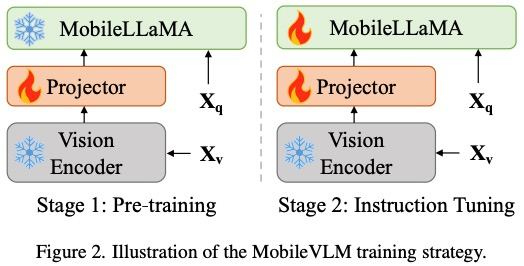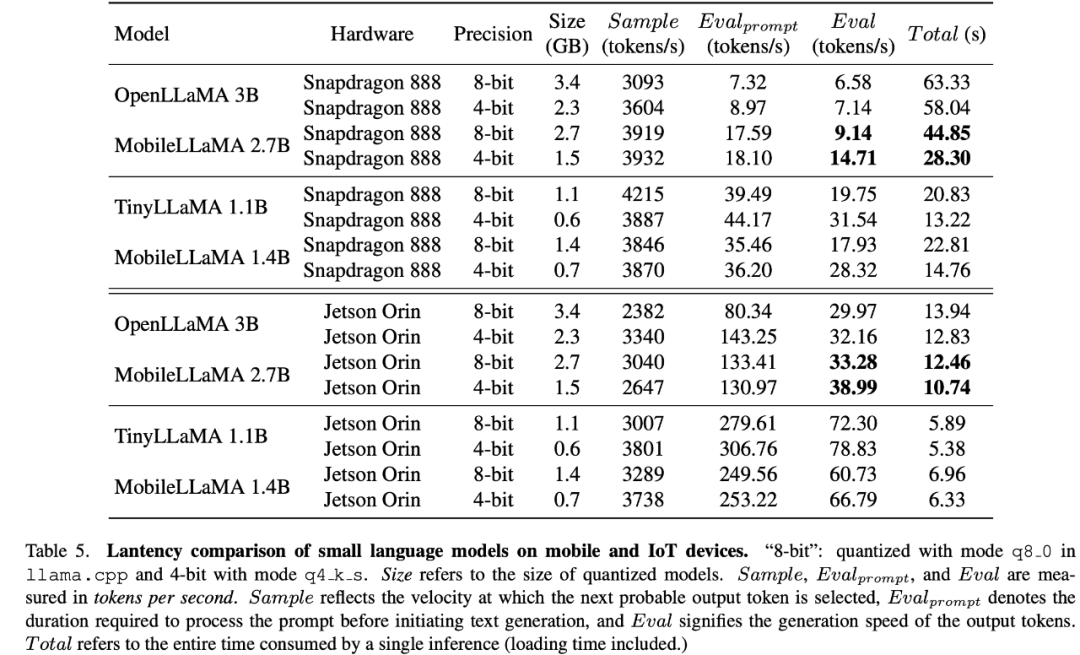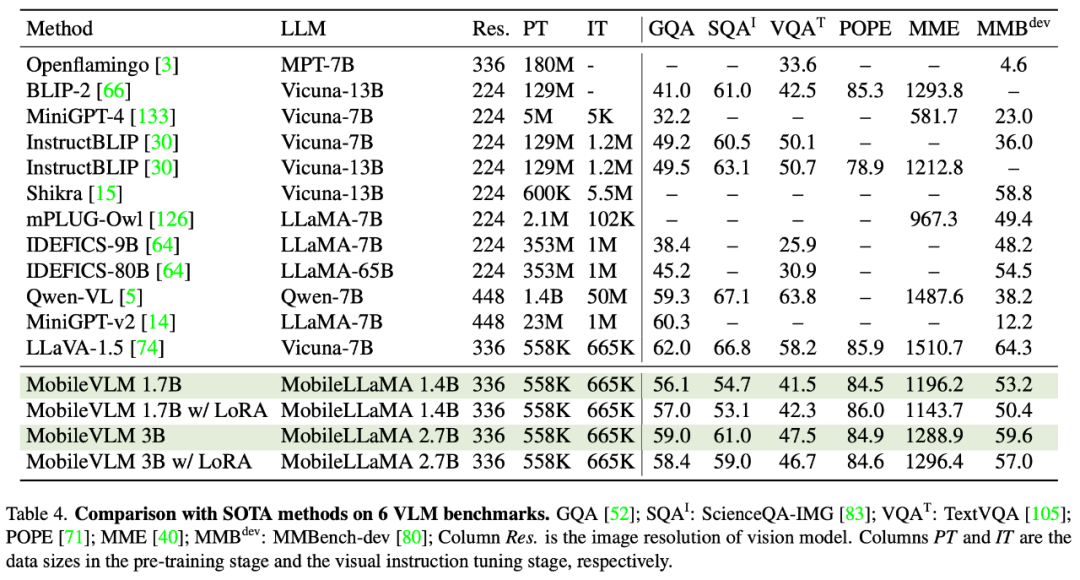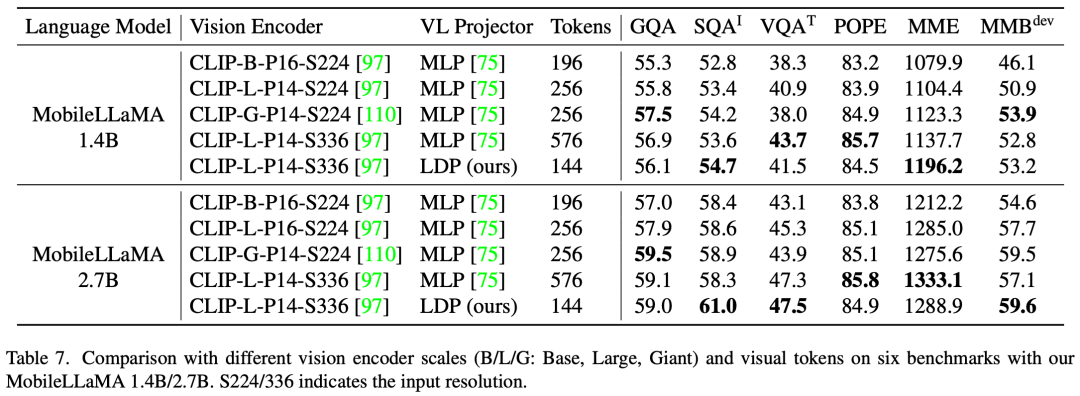 Technology peripherals
Technology peripherals
 AI
AI
 Meituan, Zhejiang University and others cooperate to create a full-process mobile multi-modal large model MobileVLM, which can run in real time and uses the Snapdragon 888 processor
Meituan, Zhejiang University and others cooperate to create a full-process mobile multi-modal large model MobileVLM, which can run in real time and uses the Snapdragon 888 processor
Meituan, Zhejiang University and others cooperate to create a full-process mobile multi-modal large model MobileVLM, which can run in real time and uses the Snapdragon 888 processor
The wave of large models coming to the mobile terminal is getting stronger and stronger, and finally someone has moved multi-modal large models to the mobile terminal. Recently, Meituan, Zhejiang University, etc. have launched multi-modal large models that can be deployed on the mobile terminal, including the entire process of LLM base training, SFT, and VLM. Perhaps in the near future, everyone will be able to own their own large model conveniently, quickly and at low cost.

Paper address: https://arxiv.org/pdf/2312.16886.pdf - ##Code address: https://github.com/Meituan- AutoML/MobileVLM
- This article proposes MobileVLM, which is a full-stack transformation of a multi-modal visual language model customized for mobile scenarios. . According to the authors, this is the first visual language model to deliver detailed, reproducible, and powerful performance from scratch. Through controlled and open source data sets, researchers have established a set of high-performance basic language models and multi-modal models.
- This paper conducts extensive ablation experiments on the design of visual encoders and systematically evaluates the performance sensitivity of VLMs to various training paradigms, input resolutions, and model sizes.
- This paper designs an efficient mapping network between visual features and text features, which can better align multi-modal features while reducing reasoning consumption.
- The model designed in this article can run efficiently on low-power mobile devices, with a measured speed of 21.5 tokens/s on Qualcomm’s mobile CPU and 65.5-inch processor.
- MobileVLM performs equally well on benchmarks as a large number of multi-modal large models, proving its application potential in many practical tasks. While this article focuses on edge scenarios, MobileVLM outperforms many state-of-the-art VLMs that can only be supported by powerful GPUs in the cloud.
Considering the main goal of achieving efficient visual perception and reasoning for resource-limited edge devices, the researchers designed the overall architecture of MobileVLM, as shown in Figure 1 , the model consists of three components: 1) a visual encoder, 2) a customized LLM edge device (MobileLLaMA), and 3) an efficient mapping network (referred to in the paper as "Lightweight Downsampling Mapping", LDP) for alignment Visual and textual space.
 as input, the visual encoder F_enc extracts the visual embedding
as input, the visual encoder F_enc extracts the visual embedding  for image perception, where N_v = HW/P^2 represents the number of image blocks and D_v represents the hidden layer size of the visual embedding. In order to alleviate the efficiency problem of processing image tokens, the researchers designed a lightweight mapping network P for visual feature compression and visual-text modal alignment. It transforms f into the word embedding space and provides appropriate input dimensions for the subsequent language model, as follows:
for image perception, where N_v = HW/P^2 represents the number of image blocks and D_v represents the hidden layer size of the visual embedding. In order to alleviate the efficiency problem of processing image tokens, the researchers designed a lightweight mapping network P for visual feature compression and visual-text modal alignment. It transforms f into the word embedding space and provides appropriate input dimensions for the subsequent language model, as follows:

 , where N_t represents the number of text tokens, and D_t represents the size of the word embedding space. In the current MLLM design paradigm, LLM has the largest amount of calculation and memory consumption. In view of this, this article tailors a series of inference-friendly LLM for mobile applications, which has considerable advantages in speed and can perform autoregressive methods. Predict multi-modal input
, where N_t represents the number of text tokens, and D_t represents the size of the word embedding space. In the current MLLM design paradigm, LLM has the largest amount of calculation and memory consumption. In view of this, this article tailors a series of inference-friendly LLM for mobile applications, which has considerable advantages in speed and can perform autoregressive methods. Predict multi-modal input , where L represents the length of the output tokens. This process can be expressed as
, where L represents the length of the output tokens. This process can be expressed as  .
. 
- Apply RoPE to inject location information.
- Apply pre-normalization to stabilize training. Specifically, this paper uses RMSNorm instead of layer normalization, and the MLP expansion ratio uses 8/3 instead of 4.
- Use SwiGLU activation function instead of GELU.


 and outputs an efficiently extracted and aligned visual token
and outputs an efficiently extracted and aligned visual token  .
. 



In Table 7, the researchers compared the multi-modal performance at different scales and different numbers of visual tokens. All experiments used CLIP ViT as the visual encoder.

Due to feature interaction and token Both interactions are beneficial. The researchers used depth convolution for the former and point convolution for the latter. Table 9 shows the performance of various VL mapped networks. Row 1 in Table 9 is the module used in LLaVA, which only transforms the feature space through two linear layers. Line 2 adds a DW (depthwise) convolution before each PW (pointwise) for token interaction, which uses 2x downsampling with a stride of 2. Adding two front-end PW layers will bring more feature-level interactions, thus making up for the performance loss caused by the reduction of tokens. Lines 4 and 5 show that adding more parameters does not achieve the desired effect. Lines 4 and 6 show that downsampling tokens at the end of the mapping network has a positive effect.

Since the number of visual tokens directly affects the entire For modal model inference speed, this paper compares two design options: reducing the input resolution (RIR) and using a lightweight downsampling projector (LDP).
at Vicuna fine-tuned on LLaMA is widely used for large multimodal models. Table 10 compares two common SFT paradigms, Alpaca and Vicuna. The researchers found that the scores of SQA, VQA, MME, and MMBench all improved significantly. This shows that fine-tuning large language models using data from ShareGPT in Vicuna conversational mode ultimately yields the best performance. In order to better integrate SFT's prompt format with the training of downstream tasks, this paper removes the conversation mode on MobileVLM and finds that vicunav1 performs best.

In short, MobileVLM is a suite of tools designed for mobile and An efficient and powerful mobile visual language model customized for IoT devices. This paper resets the language model and visual mapping network. The researchers conducted extensive experiments to select an appropriate visual backbone network, design an efficient mapping network, and enhance model capabilities through training solutions such as language model SFT (a two-stage training strategy including pre-training and instruction adjustment) and LoRA fine-tuning. . Researchers rigorously evaluated the performance of MobileVLM on mainstream VLM benchmarks. MobileVLM also shows unprecedented speeds on typical mobile and IoT devices. The researchers believe that MobileVLM will open up new possibilities for a wide range of applications such as multi-modal assistants deployed on mobile devices or autonomous vehicles, as well as broader artificial intelligence robots.
The above is the detailed content of Meituan, Zhejiang University and others cooperate to create a full-process mobile multi-modal large model MobileVLM, which can run in real time and uses the Snapdragon 888 processor. For more information, please follow other related articles on the PHP Chinese website!

Hot AI Tools

Undresser.AI Undress
AI-powered app for creating realistic nude photos

AI Clothes Remover
Online AI tool for removing clothes from photos.

Undress AI Tool
Undress images for free

Clothoff.io
AI clothes remover

Video Face Swap
Swap faces in any video effortlessly with our completely free AI face swap tool!

Hot Article

Hot Tools

Notepad++7.3.1
Easy-to-use and free code editor

SublimeText3 Chinese version
Chinese version, very easy to use

Zend Studio 13.0.1
Powerful PHP integrated development environment

Dreamweaver CS6
Visual web development tools

SublimeText3 Mac version
God-level code editing software (SublimeText3)

Hot Topics
 1655
1655
 14
14
 1414
1414
 52
52
 1307
1307
 25
25
 1254
1254
 29
29
 1228
1228
 24
24
 DeepMind robot plays table tennis, and its forehand and backhand slip into the air, completely defeating human beginners
Aug 09, 2024 pm 04:01 PM
DeepMind robot plays table tennis, and its forehand and backhand slip into the air, completely defeating human beginners
Aug 09, 2024 pm 04:01 PM
But maybe he can’t defeat the old man in the park? The Paris Olympic Games are in full swing, and table tennis has attracted much attention. At the same time, robots have also made new breakthroughs in playing table tennis. Just now, DeepMind proposed the first learning robot agent that can reach the level of human amateur players in competitive table tennis. Paper address: https://arxiv.org/pdf/2408.03906 How good is the DeepMind robot at playing table tennis? Probably on par with human amateur players: both forehand and backhand: the opponent uses a variety of playing styles, and the robot can also withstand: receiving serves with different spins: However, the intensity of the game does not seem to be as intense as the old man in the park. For robots, table tennis
 The first mechanical claw! Yuanluobao appeared at the 2024 World Robot Conference and released the first chess robot that can enter the home
Aug 21, 2024 pm 07:33 PM
The first mechanical claw! Yuanluobao appeared at the 2024 World Robot Conference and released the first chess robot that can enter the home
Aug 21, 2024 pm 07:33 PM
On August 21, the 2024 World Robot Conference was grandly held in Beijing. SenseTime's home robot brand "Yuanluobot SenseRobot" has unveiled its entire family of products, and recently released the Yuanluobot AI chess-playing robot - Chess Professional Edition (hereinafter referred to as "Yuanluobot SenseRobot"), becoming the world's first A chess robot for the home. As the third chess-playing robot product of Yuanluobo, the new Guoxiang robot has undergone a large number of special technical upgrades and innovations in AI and engineering machinery. For the first time, it has realized the ability to pick up three-dimensional chess pieces through mechanical claws on a home robot, and perform human-machine Functions such as chess playing, everyone playing chess, notation review, etc.
 Claude has become lazy too! Netizen: Learn to give yourself a holiday
Sep 02, 2024 pm 01:56 PM
Claude has become lazy too! Netizen: Learn to give yourself a holiday
Sep 02, 2024 pm 01:56 PM
The start of school is about to begin, and it’s not just the students who are about to start the new semester who should take care of themselves, but also the large AI models. Some time ago, Reddit was filled with netizens complaining that Claude was getting lazy. "Its level has dropped a lot, it often pauses, and even the output becomes very short. In the first week of release, it could translate a full 4-page document at once, but now it can't even output half a page!" https:// www.reddit.com/r/ClaudeAI/comments/1by8rw8/something_just_feels_wrong_with_claude_in_the/ in a post titled "Totally disappointed with Claude", full of
 At the World Robot Conference, this domestic robot carrying 'the hope of future elderly care' was surrounded
Aug 22, 2024 pm 10:35 PM
At the World Robot Conference, this domestic robot carrying 'the hope of future elderly care' was surrounded
Aug 22, 2024 pm 10:35 PM
At the World Robot Conference being held in Beijing, the display of humanoid robots has become the absolute focus of the scene. At the Stardust Intelligent booth, the AI robot assistant S1 performed three major performances of dulcimer, martial arts, and calligraphy in one exhibition area, capable of both literary and martial arts. , attracted a large number of professional audiences and media. The elegant playing on the elastic strings allows the S1 to demonstrate fine operation and absolute control with speed, strength and precision. CCTV News conducted a special report on the imitation learning and intelligent control behind "Calligraphy". Company founder Lai Jie explained that behind the silky movements, the hardware side pursues the best force control and the most human-like body indicators (speed, load) etc.), but on the AI side, the real movement data of people is collected, allowing the robot to become stronger when it encounters a strong situation and learn to evolve quickly. And agile
 ACL 2024 Awards Announced: One of the Best Papers on Oracle Deciphering by HuaTech, GloVe Time Test Award
Aug 15, 2024 pm 04:37 PM
ACL 2024 Awards Announced: One of the Best Papers on Oracle Deciphering by HuaTech, GloVe Time Test Award
Aug 15, 2024 pm 04:37 PM
At this ACL conference, contributors have gained a lot. The six-day ACL2024 is being held in Bangkok, Thailand. ACL is the top international conference in the field of computational linguistics and natural language processing. It is organized by the International Association for Computational Linguistics and is held annually. ACL has always ranked first in academic influence in the field of NLP, and it is also a CCF-A recommended conference. This year's ACL conference is the 62nd and has received more than 400 cutting-edge works in the field of NLP. Yesterday afternoon, the conference announced the best paper and other awards. This time, there are 7 Best Paper Awards (two unpublished), 1 Best Theme Paper Award, and 35 Outstanding Paper Awards. The conference also awarded 3 Resource Paper Awards (ResourceAward) and Social Impact Award (
 Li Feifei's team proposed ReKep to give robots spatial intelligence and integrate GPT-4o
Sep 03, 2024 pm 05:18 PM
Li Feifei's team proposed ReKep to give robots spatial intelligence and integrate GPT-4o
Sep 03, 2024 pm 05:18 PM
Deep integration of vision and robot learning. When two robot hands work together smoothly to fold clothes, pour tea, and pack shoes, coupled with the 1X humanoid robot NEO that has been making headlines recently, you may have a feeling: we seem to be entering the age of robots. In fact, these silky movements are the product of advanced robotic technology + exquisite frame design + multi-modal large models. We know that useful robots often require complex and exquisite interactions with the environment, and the environment can be represented as constraints in the spatial and temporal domains. For example, if you want a robot to pour tea, the robot first needs to grasp the handle of the teapot and keep it upright without spilling the tea, then move it smoothly until the mouth of the pot is aligned with the mouth of the cup, and then tilt the teapot at a certain angle. . this
 Hongmeng Smart Travel S9 and full-scenario new product launch conference, a number of blockbuster new products were released together
Aug 08, 2024 am 07:02 AM
Hongmeng Smart Travel S9 and full-scenario new product launch conference, a number of blockbuster new products were released together
Aug 08, 2024 am 07:02 AM
This afternoon, Hongmeng Zhixing officially welcomed new brands and new cars. On August 6, Huawei held the Hongmeng Smart Xingxing S9 and Huawei full-scenario new product launch conference, bringing the panoramic smart flagship sedan Xiangjie S9, the new M7Pro and Huawei novaFlip, MatePad Pro 12.2 inches, the new MatePad Air, Huawei Bisheng With many new all-scenario smart products including the laser printer X1 series, FreeBuds6i, WATCHFIT3 and smart screen S5Pro, from smart travel, smart office to smart wear, Huawei continues to build a full-scenario smart ecosystem to bring consumers a smart experience of the Internet of Everything. Hongmeng Zhixing: In-depth empowerment to promote the upgrading of the smart car industry Huawei joins hands with Chinese automotive industry partners to provide
 Distributed Artificial Intelligence Conference DAI 2024 Call for Papers: Agent Day, Richard Sutton, the father of reinforcement learning, will attend! Yan Shuicheng, Sergey Levine and DeepMind scientists will give keynote speeches
Aug 22, 2024 pm 08:02 PM
Distributed Artificial Intelligence Conference DAI 2024 Call for Papers: Agent Day, Richard Sutton, the father of reinforcement learning, will attend! Yan Shuicheng, Sergey Levine and DeepMind scientists will give keynote speeches
Aug 22, 2024 pm 08:02 PM
Conference Introduction With the rapid development of science and technology, artificial intelligence has become an important force in promoting social progress. In this era, we are fortunate to witness and participate in the innovation and application of Distributed Artificial Intelligence (DAI). Distributed artificial intelligence is an important branch of the field of artificial intelligence, which has attracted more and more attention in recent years. Agents based on large language models (LLM) have suddenly emerged. By combining the powerful language understanding and generation capabilities of large models, they have shown great potential in natural language interaction, knowledge reasoning, task planning, etc. AIAgent is taking over the big language model and has become a hot topic in the current AI circle. Au



